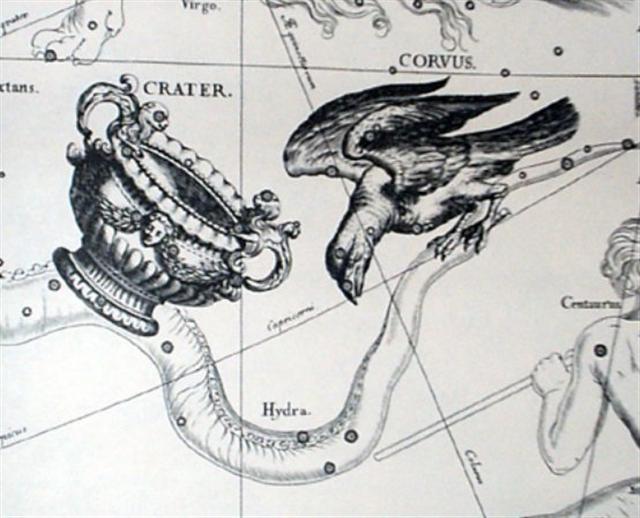Viri in Ga7-1 is designed exactly the same as the earlier viri in Ga5-11:
Possibly we should understand this pair of viri glyphs to define a 50-day long season. If so, then its midpoint ought to be of interest (which it is):
Benetnash is η Ursae Majoris, the last star in the constellation: "The name derives from the Arabic phrase meaning The leader of the daughters of the bier ... The daughters of the bier, i.e. the mourning maidens, are the three stars of the handle of the Big Dipper, Alkaid, Mizar, and Alioth; while the four stars of the bowl, Megrez, Phecda, Merak, and Dubhe, are the bier." (Wikipedia)
Manu kake (the 'climbing bird') in Ga4-21 was together with Sun (at the time of G) 24 weeks beyond equinox. From Dubhe to Benetnasch there are 6 weeks, possibly corresponding to the 42 principal districts in ancient Egypt: ... They tightly swathed the broken body in linen bandages, and when they performed over it the rites that thereafter were to be continued in Egypt in the ceremonial burial of kings, Isis fanned the corpse with her wings and Osiris revived, to become the ruler of the dead. He now sits majestically in the underworld, in the Hall of the Two Truths, assisted by forty-two assessors, one from each of the principal districts of Egypt; and there he judges the souls of the dead ... Furthermore, a definite pattern is defined by the pair of manu kake glyphs in the text:
The bird type manu kake has a longer beak in front and the fish type a longer beak at the back side. The bird type (Sun) evidently has 300 days ending with tagata in glyph 360. The fish type (Moon) could have 260 nights ending with the 'ear'. It is reasonable to assume Sun 'goes to the fishes' when Ursa Major rises heliacally, when 'his broken body has to be carried on a bier'. Possibly they carry one part of him withershins (going back ca 100 nights from the beginning of 'September, to 4h and 'May 21). The other part could be destined for the 'ear'. As to Rogo at left in Ga5-10 we should consider the similar Rogo at left in Ga6-24:
The phenomenon of Rogo at left for 45 days possibly means we should count 260 - 45 = 215 respectively 360 - 45 = 315. The star Minkar (the 'Nose') is ε in the Raven (Corvus) constellation. Half a year from spring equinox it is time for autumn equinox.
According to the tresses of Pachamama a division - perhaps reflecting the deep bend of Hydra - should be around night number 400 - 185.5 = 214.5. Maybe we should count from February 19 (because 31 + 19 = 50 = 264 - 214). The Roman (Pre-Julian) calendar, though, had only 29 days in January and 29 + 21 = 50. But I suspect the basic equation is to be found in Februarius: ... a 27-day intercalary month, the Mensis Intercalaris, was sometimes inserted between February and March. This intercalary month was formed by inserting 22 days after the first 23 or 24 days of February; the last five days of February, which counted down toward the start of March, became the last five days of Intercalaris ... 23 (24) + 22 = 45 (46). Then we have to add 5 in order to take us to 50 (51) and - by way of the G text - to the date 314 in the Gregorian calendar. 314 (November 10) - 60 (March 1) = 254 = 365 - 111:
We probably should regard the 50 days defined by the exactly alike viri signs as corresponding to the Pre-Julian moon calendar's Mensis Intercalaris. The flow of star positions in the G text is not perturbed by this (and neither are the modern calendar dates). According to G the intercalendary month could then reside in the time from autumn equinox (north of the equator) up to and including day 314 (November 10). South of the equator November is a spring month. My interpretation indicates the last 5 days in the manzil Simak (ruled by Spica) are similar to the last 5 days of the Roman Februarius, and also to the last 5 nights in the ancient 365-day year of the Egyptians, those nights which allowed Nut to give birth: ... Nut, whom the Greeks sometimes identified with Rhea, was goddess of the sky, but it was debatable if in historical times she was the object of a genuine cult. She was Geb's twin sister and, it was said, married him secretly and against the will of Ra. Angered, Ra had the couple brutally separated by Shu and afterwards decreed that Nut could not bear a child in any given month of any year. Thoth, Plutarch tells us, happily had pity on her. Playing draughts with the Moon, he won in the course of several games a seventy-second part of the Moon's light with which he composed five new days. As these five intercalated days did not belong to the official Egyptian calendar of three hundred and sixty days, Nut was thus able to give birth successively to five children: Osiris, Haroeris (Horus), Set, Isis and Nepthys ... Indeed, it supports my early interpretation of the 5 wedge marks inside mama in Ga7-3 as 5 dark nights outside the regular calendar:
Thus Syrma 1 ought to correspond to the first day in the Roman month Martius:
Glyph Ga7-7 is in position 177 and in the manzil calendar the date Syrma 1 is in position 184 (one week later). If we add 45 (the distance measured out by the pair of Rogo glyphs) to 184 it becomes 229. If we add 50 (the distance measured out by the pair of viri glyphs) it becomes 234, a glyph which corresponds to 'January 12 (day 377). Wikipedia: "The name Syrma is from the Arabic 'train' (of a garment)." The star Syrma is ι Virginis at her left knee and we have found it to be 153 days from the beginning of the front side (a week later than Benetnash and Assarfa 9 (153). 153 + 24 = 177.
The henua calendar ends with glyph 180. Then follows what clearly is a tamaiti (28 days after the possible one in Ga6-12):
The glyph picture in Ga7-19 looks like the 'ignition' of a new 'fire' (at bottom). The date Syrma 13 is 28 weeks from the beginning of the manzil calendar. The star which is connected with the following manzil Az Zubana is Acubens:
Possibly also the last 5 days in the manzil Syrma were meant to be a birth place for the gods. We can guess 6 of them according to Ga7-15. And a 7th great one could follow in the first 5 days of Az Zubana:
The 6th Rei has a an 'inversed π' position (7 / 22), and 72 * 2 = 144 = 12 * 12. Counted from the end of the henua calendar it is day number 12. Haú in Ga7-23 has 16 'feather marks' and the tip of its 'branch' has a cup-like sign. The star name Cujam refers to the Club of Hercules. A great 'fruit' ('offspring') hangs in front of this maitaki.
In Sweden the Lucia celebrations take place inside the houses in the early morning in the darkest of the months. This can be contrasted with how in Finland at midsummer they have outdoor bonfires:

From the solstice in June 21 (172) to the date of Lucia there are 347 - 172 = 175 days or 35 weeks. On Easter Island, of course, this measures the distance from the darkest time of the year to the lightest. The heliacal rising of Antares indicated the beginning of summer and the heliacal rising of Aldebaran similarly the end of summer:
Winter would then measure 365 + 148 - 329 = 184 nights. | |||||||||||||||||||||||||||||||||||||||||||||||||||||||||||||||||||||||||||||||||||||||||||||||||||||||||||||||||||||||||||||||||||||||||||||||||||||||||||||||||||||||||||||||||||||||||||||||||||||||||||||||||||||||||||||||||||||||||||||||||||||||||||||||||||||||||||||||||||||||||||||||||||||||||||||||||||||||||||||||||||||||||||||||||||||||||||||||||||||||||||||||||||||||||||||||||||||||||||||||||||||||||||||||||||||||||||||||||||||||||||||||||||||||||||||||||||


































